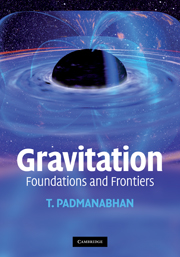Book contents
- Frontmatter
- Contents
- List of exercises
- List of projects
- Preface
- How to use this book
- 1 Special relativity
- 2 Scalar and electromagnetic fields in special relativity
- 3 Gravity and spacetime geometry: the inescapable connection
- 4 Metric tensor, geodesics and covariant derivative
- 5 Curvature of spacetime
- 6 Einstein's field equations and gravitational dynamics
- 7 Spherically symmetric geometry
- 8 Black holes
- 9 Gravitational waves
- 10 Relativistic cosmology
- 11 Differential forms and exterior calculus
- 12 Hamiltonian structure of general relativity
- 13 Evolution of cosmological perturbations
- 14 Quantum field theory in curved spacetime
- 15 Gravity in higher and lower dimensions
- 16 Gravity as an emergent phenomenon
- Notes
- Index
2 - Scalar and electromagnetic fields in special relativity
Published online by Cambridge University Press: 05 June 2012
- Frontmatter
- Contents
- List of exercises
- List of projects
- Preface
- How to use this book
- 1 Special relativity
- 2 Scalar and electromagnetic fields in special relativity
- 3 Gravity and spacetime geometry: the inescapable connection
- 4 Metric tensor, geodesics and covariant derivative
- 5 Curvature of spacetime
- 6 Einstein's field equations and gravitational dynamics
- 7 Spherically symmetric geometry
- 8 Black holes
- 9 Gravitational waves
- 10 Relativistic cosmology
- 11 Differential forms and exterior calculus
- 12 Hamiltonian structure of general relativity
- 13 Evolution of cosmological perturbations
- 14 Quantum field theory in curved spacetime
- 15 Gravity in higher and lower dimensions
- 16 Gravity as an emergent phenomenon
- Notes
- Index
Summary
Introduction
This chapter develops the ideas of classical field theory in the context of special relativity. We use a scalar field and the electromagnetic field as examples of classical fields. The discussion of scalar field theory will allow us to understand concepts that are unique to field theory in a somewhat simpler context than electromagnetism; it will also be useful later on in the study of topics such as inflation, quantum field theory in curved spacetime, etc. As regards electromagnetism, we concentrate on those topics that will have direct relevance in the development of similar ideas in gravity (gauge invariance, Hamilton–Jacobi theory for particle motion, radiation and radiation reaction, etc.).
The ideas developed here will be used in the next chapter to understand why a field theory of gravity – developed along similar lines – runs into difficulties. The concept of an action principle for a field will be extensively used in Chapter 6 in the context of gravity. Other topics will prove to be valuable in studying the effect of gravity on different physical systems.
External fields of force
In non-relativistic mechanics, the effect of an external force field on a particle can be incorporated by adding to the Lagrangian the term −V(t, x), thereby adding to the action the integral of −V dt. Such a modification is, however, not Lorentz invariant and hence cannot be used in a relativistic theory.
- Type
- Chapter
- Information
- GravitationFoundations and Frontiers, pp. 54 - 106Publisher: Cambridge University PressPrint publication year: 2010



